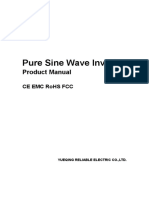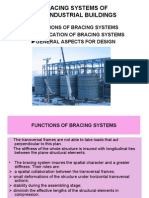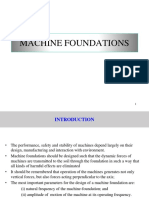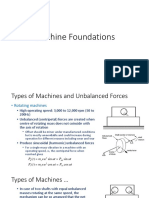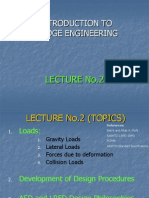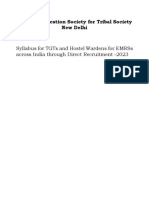Machine Foundation
Machine Foundation
Uploaded by
sujayan2005Copyright:
Available Formats
Machine Foundation
Machine Foundation
Uploaded by
sujayan2005Original Description:
Copyright
Available Formats
Share this document
Did you find this document useful?
Is this content inappropriate?
Copyright:
Available Formats
Machine Foundation
Machine Foundation
Uploaded by
sujayan2005Copyright:
Available Formats
Machines and Foundations
1-3
MACHINES AND FOUNDATIONS
The performance, safety and stability of machines depend largely on their design, manufacturing
and interaction with environment. In principle machine foundations should be designed such that
the dynamic forces of machines are transmitted to the soil through the foundation in such a way
that all kinds of harmful effects are eliminated.
In the past, simple methods of calculation were used most often involving the multiplication of
static loads by an estimated Dynamic Factor, the result being treated as an increased static load
without any knowledge of the actual safety factor. Because of this uncertainty, the value of the
adopted dynamic factor was usually too high, although practice showed that during operation
harmful deformations did result in spite of using such excessive factors. This necessitated a
deeper scientific investigation of dynamic loading. A more detailed study became urgent
because of development of machines of higher capacities.
Machines of higher ratings gave rise to considerably higher stresses thereby posing problems with
respect to performance and safety. This called for development partly in the field of vibration
technique and partly in that of soil mechanics. Hence new theoretical procedures were developed
for calculating the dynamic response of foundations.
It is well established that the cost of foundation is but a small fraction of that of the
machine and inadequately constructed foundations may result in failures and
shutdowns exceeding many times the cost of the capital investment required for
properly designed and built foundations.
1.1
AN OVERVIEW
A brief review indicates that over the years, many scientists have contributed to the field of
machine foundation design. Gieger in 1922 carried out investigations to determine the natural
frequencies of foundations. Rauch in 1924 dealt with the machine and turbine foundation and
contributed greatly to the practical and theoretical development of the science. A great emphasis
was thus laid on to vibration problems in machine foundations. Timoshenko (1928) & Den Hartog
(1934) dealt with many vibration problems in engineering practices. Later Wilson (1942), Arya
1-4
Machines and Foundations
(1958), Norris (1959), Harris and Crede (1961) contributed a lot in the field of vibration. D.Q
Barkan (1938) published his findings on dynamic effects on machine foundation. His basic work
on the results of theoretical and experimental investigation in the field of machine foundations
affected by dynamic action was published in 1948 and translated into English in 1962. Alexander
Ml'tior has also made a significant contribution in the field of machine foundation. His book on
"vibration analysis and design of foundations for machines and turbines" published in 1962
(translated from Hungarian) had been a very useful tool to deal with machine foundation problems.
Based on the scientific investigations carried out in the last few decades it has been established that
it is not enough to base the design only on vertical loads multiplied by a dynamic factor, even
if this factor introduces a dynamic load many times greater than original one. It should be
remembered that operation of the machines generated not only vertical forces, but also forces
acting perpendicular to the axis; it is thus not enough to take into account the vertical load and to
multiply it by a selected dynamic factor. It has also been found that the suitability of machine
foundations depends not only on the forces to which they will be subjected to, but also on their
behaviour when exposed to dynamic loads which depends on the speed on the machine and natural
frequency of the foundation. Thus a vibration analysis became necessary. In other words, it can be
said that each and every machine foundation does require detailed vibration analysis providing
insight in to the dynamic behaviour of foundation and its components for satisfactory performance
of the machine. The complete knowledge of load transfer mechanism from the machine to the
foundation and also the complete knowledge of excitation forces and associated frequencies are a
must for correct evaluation of machine performance.
The performance, safety and stability of machines depend largely on their design, manufacturing
and interaction with environment. In principle machine foundations should be designed such that
the dynamic forces of machines are transmitted to the soil through the foundation in such a way
that all kinds of harmful effects are eliminated. Hence, all machine foundations, irrespective of size
and type of machine, should be regarded as engineering problem and their design should be based
on sound engineering practices. The dynamic loads from the machines causing vibrations must
duly be accounted for to provide a solution, which is technicalIy sound and economical. For a
technically correct and economical solution, a close co-operation between manufacturer and the
foundation designer is a must.
Vibration problems have been drawing attention of scientists and engineers, since decades, world
over to find ways and means to have desired satisfactory performance of machines and to minimize
failures. In the past, due importance was not given to the machine foundation design. Simple
methods of calculation were used for strength design of the foundation by multiplying static loads
with an estimated Dynamic Factor. This resulted in consideration of increased static loads without
any knowledge of actual safety factor. Even with these so-called excessive loads, harmful effects
were observed during operation. Based on the scientific investigations carried out in the last few
decades it has been established that it is not enough to base the design on vertical loads only,
multiplied by an arbitrary Dynamic Factor.
Improvement in manufacturing technology has provided machines of higher ratings with better
tolerances and controlled behaviour. The increased dependence of society on machines provides
no room for failure and deinands equipment and systems with higher performance reliability. All
Machines and Foundations
1-5
problems could not be solved theoretically because a good amount of assumptions had to be made
for the analysis and these assumptions needed validation through experiments. Laboratory and field
measurements were thus introduced to determine carefully the effects of various parameters on the
dynamic response of machine foundation. Thus a detailed vibration analysis became necessary. It
was also realised that a careful dynamic investigation of soil properties is essential as the elastic
properties of the soil exercise considerable influence on the design of the foundation.
It is obvious that the cost of machine foundation is a small fraction of that of the equipment and
inadequately constructed foundations may result in failures and shutdowns whose cost itself may
exceed many times the cost of the properly designed and built foundations. Though, advanced
computational tools are available for precise evaluation of dynamic characteristics of machinefoundation system, their use in design office, which was limited in the past, has now been found to
be quite common.
The machine foundation system can be modeled either as a two-dimensional structure or threedimensional structure. For mathematical modeling and analysis, valid assumptions are made
keeping in view the following:
The mathematical model should be compatible to the Prototype structure within a
reasonable degree of accuracy
The mathematical model has got be such that it can be analysed with the available
mathematical tools
The influence of each assumption should be quantitatively known with regard to the
response of the foundation
Vibration isolation techniques have also been used to reduce vibrations in the machines. Isolation
leads to reduction in the transmissibility of the exciting forces from the machine to the foundation
and vice-versa. Uses of vibration isolation devices is one of the methods by which one can achieve
satisfactory performance which in tum can result in minimising failures and reduce downtime on
account of high vibrations. However, for equipment on elevated foundations, it is desirable to have
support structure stiffness sufficiently higher than overall stiffuess of isolation system in order to
get the desired isolation efficiency.
The support structure, a 3-D elevated structural system, possesses many natural frequencies. The
vibration isolation system, comprising o[machine, inertia block and the isolation devices, also has
six modes of vibration having specific stiffuess values corresponding to each mode of vibration.
Hence the comparison between stiffuess of structure and isolator becomes complex task. It is of
interest to note that lateral stiffness of elevated structures is very much lower than its vertical
stiffness. If this lower, (lateral) stiffuess is comparable to the stiffuess of isolators, it certainly
affects the overall stiffness and thereby the response of the machine foundation system. Hence,
lateral stiffness of support structure must also be computed and considered while selecting the
isolators. Finally it may be desirable to carry out detailed dynamic analysis of the complete system
including substructure. .
'\
1-6
Machines and Foundations
1.2
DESIGN PIDLOSOPHY
Machine foundation system, in broader sense, comprises of machine, supported by foundation
resting over soil subjected to dynamic loads i) generated by machine itself; ii) applied externally,
or iii) caused by external sources and transmitted through soil. A typical system is as shown in
Figure 1.2-1.
,i-i);~~i~lC~~ct;:,
,
Internally
:
'" ,,, ____________
generated J:
O.K.
f-F~r~;-fu,Di~j~int;g
----I
: machine & due to shock,
-I~---'
,
: .Impact, earthk
qua e etc , /'
!-o'
1______ - - - - - - - - - - - - - - - _ /
Figure 1.2-1
Machine Foundation System Qualification Subjected to Dynamic Loads
Irrespective of the source of dynamic load, the basic philosophy underlying design of machine
foundation is that:
The dynamic forces of machines are transmitted to the soil through the foundation in such
a way that all kinds of harmful effects are eliminated and the amplitudes of vibration of
the machine as well as that of the foundation are well within the specified limits.
Machines and Foundations
1.3
1-7
Foundation is structurally safe to withstand all static and dynamic forces generated by the
machine. To accomplish these objectives, every foundation needs to be analysed for
Dynamic Response, and thereafter for Strength Design
MACHINE FOUNDATION SYSTEM
In any. machine foundation system, the equipment (the machine) is considered supported by a
foundation and the foundation in tum rests on the soil. A typical machine foundation system is as
shown in Figure 1.3-1.
Interface
Machine & Foundation
Foundation
Interface
Foundation & Soil
Figure 1.3-1 A Typical Machine Foundation System
At this stage it is necessary to address as to how the equipment, foundation and soil are
interconnected.
Machine could either be connected to the foundation directly through the foundation bolts,
or it could be connected through isolation devices.
Foundation could either be a solid block resting diI:ectly on the soil or it may be resting on
the piles.
The foundation could also be a frame structure (Frame Foundation) resting directly on the
soil or it could be resting on the group of piles.
These interfaces, therefore, are essential to be appropriately addressed, for evaluating the dynamic
response of the machine correctly. Thus, the three main constituents of machine foundation system
that play significant role in overall controlling machine performance are, machine, foundation
and soil and these need to be adequately addressed. Modeling and Analysis are adequately
covered in Chapter 8.
1-8
Machines and Foundations
1.4
MACHINES
Based on type of motion, the machines are broadly classified as:
a)
b)
c)
Rotary Machines
Reciprocating Machines
Impact Type Machines
Based on the speed of operation, the machines are grouped as:
a)
Very low speed machines (up to 100 rpm)
b) Low speed machines (100 tol500rpm)
c)
Medium speed machines (1500 to 3000rpm)
d) High speed machines (3000 rpm and above)
For foundation design, broadly, the following information is needed:
Geometric configuration of the machine
Loads from machine: Mass of the stationary as well as rotating parts of the machine and
load-transfer mechanism from the machine to the foundation
Critical machine performance parameters: Critical speeds of rotors, balance grade and
acceptable levels of amplitudes of vibration
Dynamic forces generated by the machine: Forces generated under various operating
conditions and their transfer mechanism to the foundation for dynamic response analysis
Additional Forces: Forces generated under emergency or faulted conditions, Test
condition, Erection condition & Maintenance condition of the machine, Forces due to
bearing failure (ifappJicable) for strength analysis of the foundation
These parameters are covered in detail in Chapter 6.
1.5
FOUNDATION
Machine type and its characteristics do play a significant role while selecting the type of
foundation. Most commonly used foundations in the industry are Block foundations and Frame
foundations that are covered in this handbook.
1-9
Machines and Foundations
Foundation Block
Figure 1.5-1 A Typical Block Foundation
1.5.1
Block Foundation
In this case, machine is mounted over a solid block, generally made of concrete. This block in tum
rests directly on the soil. In this case both machine and foundation block are considered as nonelastic inertia bodies and the soil is treated as mass less elastic media i.e. having only stiffness and
no inertia. Schematic view of a typical block foundation is shown in Figure 1.5-1.
Machine
Deck Slab
Figure 1.5-2 A Typical Frame Foundation
1.5.2
Frame Foundation
In this type of foundation, machine is supported on the deck slab. This deck slab in tum is
supported on base raft through columns and base raft rests directly over soil or on group of piles.
Size of deck slab, number of columns, height of columns above base raft etc. are primarily
dependent on machine layout. In this case machine is treated as nOn-elastic inertia body whereas
deck slab, and columns are considered as elastic inertia bodies and soil is considered as elastic
Machines and Foundations
1-10
media. In certain specific cases, base raft is also considered as elastic inertia body. Schematic view
of a typical frame foundation is shown in Figure 1.5-2.
1.5.3
Tuning of the Foundation
Foundation, for which its vertical natural frequency is above the operating speed of the machine, is
termed as over-tuned foundation or high-tuned foundation and the foundation, for which its
vertical natural frequency is below the operating speed of the machine, is termed as under-tuned
foundation or low-tuned foundation.
1.5.4
Foundation Material
Plain Concrete, Brick, Reinforced Cement Concrete, Pre-Stressed Concrete and Steel are the
material employed for machine foundation construction. Foundations using steel structures have
also been used for frame foundations. The sizes of structural members in steel foundations are less
than those for RCC foundations and accordingly their space requirement is much less. As regards
vibration, steel structures undoubtedly involve' higher risk. Natural frequencies are low and the
foundation is deeply under-tuned. The resistance to fire of a steel structure is lower than that of
reinforced concrete one. Most high tuned foundations are built of reinforced concrete. Vibration
amplitudes are reduced due to relatively higher damping present in the concrete.
1.5.5
Foundation Analysis and Design
Every foundation is analysed for its dynamic response and checked for strength and stability. Using
the machine, soil and foundation parameters, amplitUdes of vibration are computed at machine as
well as foundation level. In addition foundation is designed for its strength and stability to
withstand applicable static and dynamic forces. For this the dynamic forces of the machine are
translated into equivalent static forces on the foundation. Strength check of the foundation is also
done for forces due to environmental effects like wind & earthquake etc.
Should the strength analysis indicate need for change in the foundation size, a recheck on the
dynamic analysis with the revised foundation size is a must. Typical foundation parameters needed
for design of machine foundation system are:
Foundation geometry
Material properties i.e. mass density, dynamic modulus of elasticity, Poisson's ratio,
coefficient of thermal expansion, etc.
Strength parameters i.e. Yield stress, UTS, Allowable stress in compression, tension,
bending and shear, etc.
These parameters in detail are covered in chapter 7. Construction aspects of these foundations are
covered in Chapter 13.
Machines and Foundations
1.6
1-11
SOIL
It is an established fact that the soil properties significantly influence the dyrtamic response of
machine foundation system. Identical machines with identical foundations have been reported to
behave differently in different soil conditions. For block foundation, the soil influence is
predominant. The dynamic response largely depends upon mass of the machine, mass of the block,
the geometry of the block and soil dynamic properties. However for frame foundations, it is
generally reported that consideration of soil structure interaction i) induces additional modes
pertaining to soil deformation with relatively low frequencies and ii) has a tendency to marginally
enhance structural frequencies.
Soil system is a complex entity in itself and there are many uncertainties associated with its
modeling. Correct evaluation of dynamic soil properties, however, is the most difficult task. These
properties may vary from site to site, from location to location and from machine to machine as
well as with variation of depth of foundation. Under the influence of dynamic forces, the
foundation interacts with the soil activating dynamic soil structure interaction, which significantly
influences the dynamic response of machine foundation system.
Depending upon type of analysis, soil is represented as an elastic half space with the help of
equivalent soil springs represented by elastic sub-grade reaction coefficients. Typical soil
parameters and dynamic properties of soil used in machine foundation design are:
Young's Modulus of Elasticity
Shear modulus
Poisson's ratio
Mass density
Soil damping
Cu
Coefficients of uniform compression of the soil
C;
Coefficients of non-uniform compression of the soil
Cr
Coefficients of uniform shear of the soil
c", -'
Coefficients of non-uniform shear of the soil
The significant aspects of soil properties, which influence soil structure interaction, are: Energy
Transfer Mechanism, Soil Mass Participation in Vibration of Foundations, Effect of Embedment of
Foundation, Applicability of Hook's Law to Soil, Reduction in Permissible Soil Stress and
Dynamic Soil Parameters.
These influences have suitably been addressed in Chapter 5.
1-12
1.7
Machines and Foundations
VIBRATION ISOLATION
Isolation means reduction in the transmissibility of the exciting forces from the machine to the
foundation and vice-versa. Vibration isolation devices have been used to achieve satisfactory
performance. Isolation in broader sense includes the following:
Control of transmission of dynamic forces from machine to the foundation and thereby to
the adjoining structures and equipment
Isolation of equipment from the vibration effects of the adjoining system
Isolation from external forces like Earthquake Shock, Blast etc.
For cases, where a bunch of vibratory machines are to be mounted on a common elevated platform,
vibration isolation may tum out to be a better proposition. Vibration Isolation Design for machine
foundation systems includes, isolation requirement, isolation design, selection of isolation devices,
influence of sub-structure (wherever applicable) on the response, etc.
Basic theory of Vibration Isolation is dealt in Chapter 4 and the design of foundations with
Vibration Isolation System is covered in Chapter 12.
1.8
FIELD PERFORMANCE AND FEED BACK
It goes without saying that proof of the pudding is in eating only. A feed back from the site for the
machine's performance therefore is essential. The data needs to be recorded at frequent intervals at
site, compiied over a period of time and feedback provided to design office for drawing necessary
inferences from the same and use these for design updates.
It is the general practice in the industry to pay more attention only to those machines that do
not perform well. More often than not, for every malfunction one keeps on trying modifications in
the machine like better balancing, replacing bearings etc till satisfactory results are achieved. It is
worth noting that every time the malfunction occurs the cause may not be machine alone but it
could be foundation too. In certain cases, desired results could be achieved by correcting the
source, which may be other than the machine.
In the opinion of the author, the data for healthy machines also need to be studied at regular interval
and feedback given to designers. This will certainly help in improving design methodologies.
Some case studies are covered in Chapter 14.
PART - I
THEORY OF VIBRATION
Basic Understanding with Specific Application
To
Machine Foundation Design
2. Single Degree of Freedom System
3. Multi Degree of Freedom System
4. Vibration Isolation
You might also like
- Designing A Machine Foundation For A 10Document5 pagesDesigning A Machine Foundation For A 10frexis11100% (2)
- Machine Foundation DesignDocument62 pagesMachine Foundation DesignRam Varanasi80% (5)
- Machine Foundation DesignDocument44 pagesMachine Foundation Designjhoward2012np100% (3)
- Machine FoundationsDocument19 pagesMachine FoundationsVijay Raj100% (1)
- Genset Concrete Pad Detail-SignedDocument1 pageGenset Concrete Pad Detail-SignedJOSEPH ANTHONY VINCE MOICONo ratings yet
- Section 1630 - Minimum Design Lateral Forces and Related EffectsDocument1 pageSection 1630 - Minimum Design Lateral Forces and Related EffectsAbdul Rauf100% (1)
- 1979 Theory of International Politics by Kenneth WaltzDocument128 pages1979 Theory of International Politics by Kenneth WaltzNakor8486% (7)
- Pure Sine Wave Inverter Manual PDFDocument13 pagesPure Sine Wave Inverter Manual PDFmuhaned190100% (2)
- Kerr MicrosDocument7 pagesKerr MicrosFabian LuxNo ratings yet
- Machine FoundationDocument4 pagesMachine Foundationp kishorNo ratings yet
- Dynamic Analysis of Machine FoundationDocument8 pagesDynamic Analysis of Machine Foundationdeepak_dce_meNo ratings yet
- Analysis of Machine Foundation Vibrations State ofDocument42 pagesAnalysis of Machine Foundation Vibrations State ofHakan KeskinNo ratings yet
- Machine FoundationDocument3 pagesMachine FoundationVivek DhutNo ratings yet
- Dynamic Analysis of Machine FoundationDocument15 pagesDynamic Analysis of Machine FoundationSMT VIETNAMNo ratings yet
- BY Pooja Pingle: Structwel Designers & ConsultantsDocument23 pagesBY Pooja Pingle: Structwel Designers & ConsultantssachinapkarNo ratings yet
- Machine Vibration FoundationDocument17 pagesMachine Vibration FoundationAdigwe George ChimaNo ratings yet
- Machine FoundationDocument24 pagesMachine FoundationMASILAMANI T100% (2)
- Machine FoundationDocument12 pagesMachine FoundationEdward Razorhands100% (1)
- Design of Machine FoundationsDocument39 pagesDesign of Machine FoundationsErind MaciNo ratings yet
- Machine Foundation: Prepared byDocument8 pagesMachine Foundation: Prepared byBilal Ahmad Thoker100% (1)
- Machin FoundationDocument2 pagesMachin FoundationPrudhvi Royal100% (1)
- Foundation Design Philosophy For Rotating EquipmentDocument7 pagesFoundation Design Philosophy For Rotating Equipmentram_babu_59No ratings yet
- Generator Foundation MountingsDocument2 pagesGenerator Foundation MountingsSuresh Gunasekara100% (2)
- Anchor Bolt: Steel Structures in IndustryDocument15 pagesAnchor Bolt: Steel Structures in Industryvenugopal BedadakotaNo ratings yet
- Machine Foundation: Digital Assignment - 2 Name: Sai Bhavith Ev REG NO: 17MST0004Document21 pagesMachine Foundation: Digital Assignment - 2 Name: Sai Bhavith Ev REG NO: 17MST0004yedida v r aviswanadh100% (1)
- Lecture - 3 Design LoadsDocument62 pagesLecture - 3 Design Loadshammads88No ratings yet
- Iv. Machinery Foundation Learning Outcome: I. Definition of FoundationDocument11 pagesIv. Machinery Foundation Learning Outcome: I. Definition of FoundationRab Bel As J.No ratings yet
- Analysis and Design of Residental Building in Etabs SoftwareDocument13 pagesAnalysis and Design of Residental Building in Etabs SoftwareMahesh PaneruNo ratings yet
- Design and Analysis of Intez Type Water Tank Using SAP 2000 SoftwareDocument7 pagesDesign and Analysis of Intez Type Water Tank Using SAP 2000 SoftwareIJRASETPublicationsNo ratings yet
- Foundation Design PhilosophyDocument38 pagesFoundation Design PhilosophyChiedu OkonduNo ratings yet
- Dynamic Analysis and Structural Design of Turbine Generator FoundationsDocument12 pagesDynamic Analysis and Structural Design of Turbine Generator FoundationsGowrishankar1987100% (1)
- 2017 Dynamic Analysis of Pile Supported Machine FoundationDocument7 pages2017 Dynamic Analysis of Pile Supported Machine FoundationBilal LoveNo ratings yet
- Design of Turbo Generator FoundationDocument2 pagesDesign of Turbo Generator Foundationatgsganesh100% (1)
- Pullout Strength of Anchor in TensionDocument3 pagesPullout Strength of Anchor in TensionYadi PermadiNo ratings yet
- Machine Foundation Digital Assignment 2: (1) Types of Machines, Capacity, Operating FrequencyDocument40 pagesMachine Foundation Digital Assignment 2: (1) Types of Machines, Capacity, Operating Frequencyyedida v r aviswanadh100% (3)
- Bracing Systems of Industrial BuildingsDocument9 pagesBracing Systems of Industrial BuildingsNicu Pascaluta0% (1)
- Machine FoundatioonDocument12 pagesMachine FoundatioonSantosh Kumar AllamNo ratings yet
- 425-Chp7-Bond Development Length SplicesDocument41 pages425-Chp7-Bond Development Length SplicesAhsan BuriroNo ratings yet
- Machine FoundationDocument42 pagesMachine FoundationRakesh SapkotaNo ratings yet
- Machine Foundation AnalysisDocument39 pagesMachine Foundation AnalysisramirovillegasNo ratings yet
- Wind Turbine Anchor SolutionsDocument8 pagesWind Turbine Anchor SolutionsplatanospanosNo ratings yet
- DSG-SE-02 Tank Found Concrete Ring WallDocument5 pagesDSG-SE-02 Tank Found Concrete Ring Wallmedhat145100% (2)
- Seminar Wind LoadDocument18 pagesSeminar Wind LoadKaustubh JadhavNo ratings yet
- Asep Steel SectionsDocument87 pagesAsep Steel SectionsGilven Beamond MedinaNo ratings yet
- Foundation Design Philosophy For Rotating EquipmentDocument7 pagesFoundation Design Philosophy For Rotating EquipmentApratim DasguptaNo ratings yet
- Machine Foundations 1Document36 pagesMachine Foundations 1eqa amirNo ratings yet
- NCSP 2015Document9 pagesNCSP 2015Jheric James Echon100% (1)
- Beam SlabDocument66 pagesBeam Slabmadkik100% (1)
- Chapter 5 Flexural MembersDocument40 pagesChapter 5 Flexural MembersAriel Dela CruzNo ratings yet
- Weld Polar Area Moment of Inertia Calculation For Welding JointDocument4 pagesWeld Polar Area Moment of Inertia Calculation For Welding JointpipestressNo ratings yet
- Lecturenote - 1071110427chapter-Vii-Design of Machine FoundationsDocument20 pagesLecturenote - 1071110427chapter-Vii-Design of Machine FoundationsBitrus Kuna DangyaraNo ratings yet
- 2 M High Free Standing WallDocument20 pages2 M High Free Standing WallAnonymous ciKyr0tNo ratings yet
- FEM Manual For STAAD - PlatesDocument46 pagesFEM Manual For STAAD - PlatesShamaNo ratings yet
- FOUNDATIONS FOR INDUSTRIAL MACHINES AND EARTHQUAKE EFFECTS - K.G. Bhatia - ISET Journal of Earthquake Technology, Paper No. 495, Vol. 45, No. 1-2, March-June 2008, Pp. 13-29Document17 pagesFOUNDATIONS FOR INDUSTRIAL MACHINES AND EARTHQUAKE EFFECTS - K.G. Bhatia - ISET Journal of Earthquake Technology, Paper No. 495, Vol. 45, No. 1-2, March-June 2008, Pp. 13-29R Mani MuruganNo ratings yet
- Industrial machineries foundationDocument3 pagesIndustrial machineries foundationBINBUSHNo ratings yet
- Foundations For Industrial Machines andDocument17 pagesFoundations For Industrial Machines andkali1No ratings yet
- Iset495 KG BatiaDocument17 pagesIset495 KG BatiaMukesh ShettyNo ratings yet
- Industrial Machines and Earthquake Effects of FoundationDocument9 pagesIndustrial Machines and Earthquake Effects of FoundationSivasanthosh CNo ratings yet
- Dynamic Analysis of Machine Foundation: When A Static Force Cannot Give The Full PictureDocument14 pagesDynamic Analysis of Machine Foundation: When A Static Force Cannot Give The Full Pictureitzsouvik007No ratings yet
- A Study of Vibrating FoundationDocument14 pagesA Study of Vibrating Foundationduda_sekaNo ratings yet
- Dynamic Analysis of Single Cylinder Compressor BloDocument6 pagesDynamic Analysis of Single Cylinder Compressor Blomohamedsaied221980No ratings yet
- 1 2023Document13 pages1 2023sharathrajsr18No ratings yet
- Dynamic Analysis and Structural Design of Turbo Generator FoundationDocument10 pagesDynamic Analysis and Structural Design of Turbo Generator FoundationAy ChNo ratings yet
- Reactor ThermalhydraulicsDocument17 pagesReactor Thermalhydraulicssujayan2005No ratings yet
- The Quick Access ToolbarDocument81 pagesThe Quick Access Toolbarsujayan2005No ratings yet
- Fuel For SMRDocument9 pagesFuel For SMRsujayan2005No ratings yet
- C TutorialDocument300 pagesC Tutorialsujayan2005No ratings yet
- C++ Date and TimeDocument3 pagesC++ Date and Timesujayan2005No ratings yet
- Titanium To Ss JointDocument5 pagesTitanium To Ss Jointsujayan2005100% (1)
- Recent Comments: Home 01 Neet - Aipmt - Jee Main Mcqs Jee Main, Aipmt Mcqs Set 21Document4 pagesRecent Comments: Home 01 Neet - Aipmt - Jee Main Mcqs Jee Main, Aipmt Mcqs Set 21sujayan2005No ratings yet
- Kinematics of CM 11 Convected Coordinates RatesDocument2 pagesKinematics of CM 11 Convected Coordinates Ratessujayan2005No ratings yet
- Recent Comments: Home 01 Neet - Aipmt - Jee Main Mcqs Jee Main, Neet Mcqs Set 20Document5 pagesRecent Comments: Home 01 Neet - Aipmt - Jee Main Mcqs Jee Main, Neet Mcqs Set 20sujayan2005No ratings yet
- Delhi: Toxic Formalin Being Used To Preserve Fish: Follow Email AuthorDocument4 pagesDelhi: Toxic Formalin Being Used To Preserve Fish: Follow Email Authorsujayan2005No ratings yet
- Ragheb-Neutron Cross Sections-2011 PDFDocument26 pagesRagheb-Neutron Cross Sections-2011 PDFsujayan2005No ratings yet
- Multidimensional Reactor Systems in Diffusion Theory PDFDocument19 pagesMultidimensional Reactor Systems in Diffusion Theory PDFsujayan2005No ratings yet
- Kinematics of CM 13 Variation Linearisation PDFDocument7 pagesKinematics of CM 13 Variation Linearisation PDFsujayan2005No ratings yet
- Introduction To Bridge EngineeringDocument125 pagesIntroduction To Bridge Engineeringjaffna100% (1)
- PI8000 Manual MV110716EDocument187 pagesPI8000 Manual MV110716ELuis StevensNo ratings yet
- CECC-3 M2 Quiz No. 1 / Set A NOV. 7, 2022Document1 pageCECC-3 M2 Quiz No. 1 / Set A NOV. 7, 2022Johannie Nina ClaridadNo ratings yet
- SR4A, SR6A, SR8A, SR9A, SR32A Static Voltage Regulators: FeaturesDocument4 pagesSR4A, SR6A, SR8A, SR9A, SR32A Static Voltage Regulators: FeaturesCarlos RiveraNo ratings yet
- How To Calculate Inertial Force of MassDocument2 pagesHow To Calculate Inertial Force of MassJohn Wilson MalonesNo ratings yet
- Induction Machines and Synchronous Machines (3-2-0)Document2 pagesInduction Machines and Synchronous Machines (3-2-0)Imran JkNo ratings yet
- Syllabus For The Post of TGT Amp Hostel WardenDocument56 pagesSyllabus For The Post of TGT Amp Hostel Wardenkartik anandNo ratings yet
- 4 - Momentum N ImpulseDocument33 pages4 - Momentum N ImpulseShivaranjini RamendranNo ratings yet
- Accu Charge 193111-0552Document43 pagesAccu Charge 193111-0552Juan Azabache100% (1)
- Neural Adaptive Control by State Space System UPFC (SSNN) For Compensation of Active and Reactive PowerDocument7 pagesNeural Adaptive Control by State Space System UPFC (SSNN) For Compensation of Active and Reactive PowerKrimo de SaidaNo ratings yet
- Ac GeneratorDocument19 pagesAc GeneratorSuraj Tandon38% (8)
- Notes For Chapter 20Document28 pagesNotes For Chapter 20edsoneiccNo ratings yet
- Ajuste CMT 01 (GE F650)Document2 pagesAjuste CMT 01 (GE F650)Franco CarrilloNo ratings yet
- EPRI - Plant Maintenance-99 PDFDocument6 pagesEPRI - Plant Maintenance-99 PDFtrankus01No ratings yet
- Aeef 0.5HP 4P 440V PDFDocument1 pageAeef 0.5HP 4P 440V PDFdee weeNo ratings yet
- Tutorial Chapter 7Document2 pagesTutorial Chapter 7Fareez SedakaNo ratings yet
- NTDC Telecom Panels 48Vdc Supply Points: Panel 1 Panel 2 Panel 3 Panel 4Document1 pageNTDC Telecom Panels 48Vdc Supply Points: Panel 1 Panel 2 Panel 3 Panel 4Junaid BashirNo ratings yet
- Voltage Drop CalculationDocument2 pagesVoltage Drop CalculationNh Chuminda YapaNo ratings yet
- Detuned ReactorsDocument4 pagesDetuned Reactorsshaikhsajid242No ratings yet
- Physics Formulas - List of All Physics Formulas With ExamplesDocument5 pagesPhysics Formulas - List of All Physics Formulas With Examplesmarvellousmomoh791No ratings yet
- 1) Preliminarno Odredjivanje Debljine Ploce: PodaciDocument8 pages1) Preliminarno Odredjivanje Debljine Ploce: PodacitrebaraNo ratings yet
- 900EFR-BL-U Earth Fault Relay: FeaturesDocument2 pages900EFR-BL-U Earth Fault Relay: FeatureschinnathambijNo ratings yet
- Kinematics in One DimensionDocument38 pagesKinematics in One DimensionQassem MohaidatNo ratings yet
- FM 5-0 Operations Process 2010Document252 pagesFM 5-0 Operations Process 2010Herwig Preining100% (1)
- Epm Group AssignmentDocument10 pagesEpm Group AssignmentMuhammad ZikryNo ratings yet
- Random Walk/Diffusion: 2.1 Langevin EquationDocument12 pagesRandom Walk/Diffusion: 2.1 Langevin EquationFredy OrjuelaNo ratings yet
- Lab 1 Eng - MechanicsDocument6 pagesLab 1 Eng - MechanicsChinna RutiranNo ratings yet







